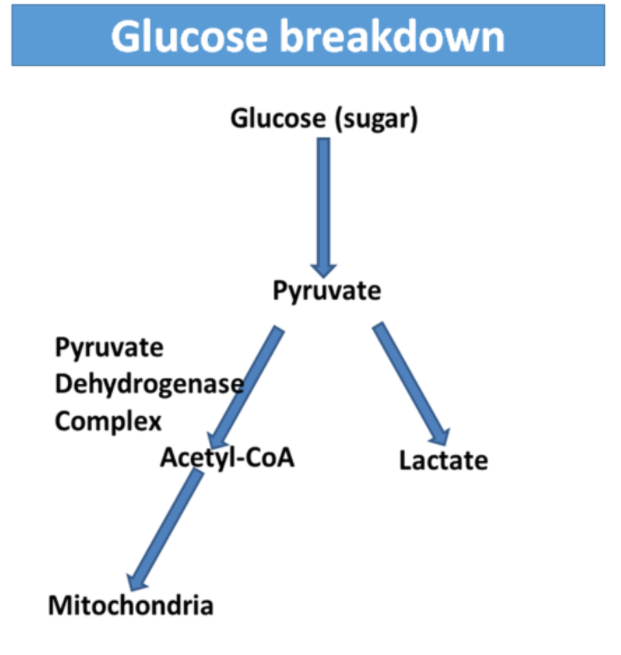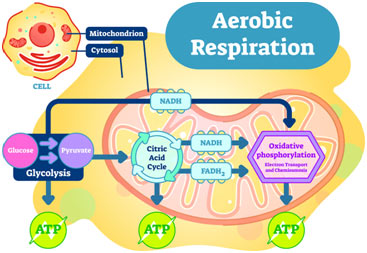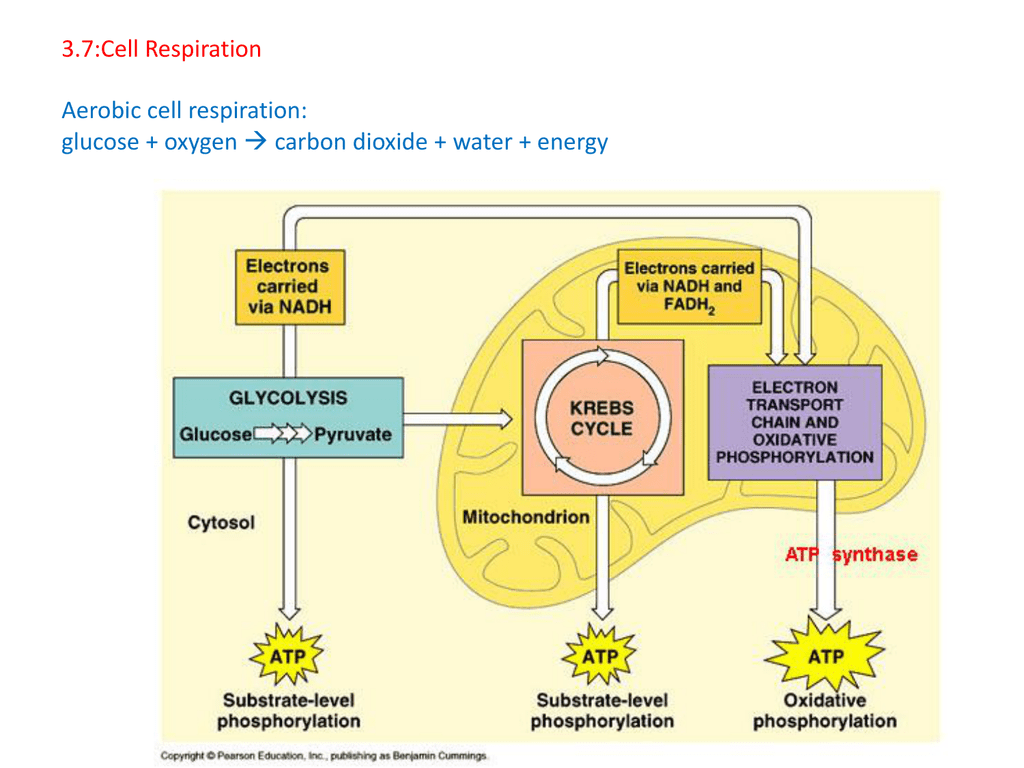During Anaerobic Respiration Glucose Molecules Are Converted Into Molecules of
All of the choices are correct. It only occurs in the cytoplasm of the cell.

Cellular Respiration Cellular Respiration Breaks Down Glucose Molecules And Banks Their Energy In Atp The Process Uses O2 And Releases Co2 And H2o Glucose Ppt Download
Two molecules of carbon dioxide are released as the byproduct.

. It happens in the cytoplasm. Hence organism A can convert glucose into alcohol. A Both the statements are individually true and the Statement II is.
Oxygen is needed to help the process of turning glucose into ATP. Are each converted into a two-carbon molecule joined to a coenzyme A molecule. Yeast behaves like organism A.
Anaerobic respiration is a type of respiration where oxygen is not used. Both processes begin with the splitting of a six-carbon sugar molecule into 2 three-carbon pyruvate molecules in a process called glycolysisThis process consumes two ATP molecules and creates four ATP for a net gain of two ATP per sugar. During anaerobic respiration number of ATP molecules generated by the breakdown of 20 glucose molecule is.
During glycolysis glucose is converted to two molecules of pyruvic acid. Why is oxygen required in mitochondria during aerobic respiration. What is anaerobic in cellular respiration.
During cellular respiration glucose is converted into two pyruvic acid molecules. In anaerobic respiration one molecule of glucose is broken down into two molecules of ethanol in yeast or lactic acid in muscle cells with a net gain of two molecules of ATP adenosine triphosphate. Glycolysis is the first stage of cellular respiration and is an anaerobic process.
Anaerobic respiration has two stages. Glucose lactic acid ATP made The lactic acid is a waste product. Aerobic cell respiration glycolysis the Krebs cycle respiratory electron transport produces 36 ATPglucose consumed.
In anaerobic respiration glucose breaks down to form alcohol and carbon dioxide with the release of small amount of energy. Thus the ATP molecules produced in anaerobic. The citric acid cycle.
Thus when 20 molecules of glucose will break down anaerobically they will produce 40 molecules of ATP. The later steps release much more ATP. ATP is produced by phosphorylation of ADP.
So the glucose in our body is converted into lactic acid during strenuous exercise. There is lactate production in animals and ethanol plus carbon dioxide in plants. Some plants microorganisms and.
The initial step releases just two molecules of ATP for each glucose. Therefore the net production of ATP is only 2 ATP. Instead organic or inorganic molecules are used as final electron acceptors.
Anaerobic respiration is a form of respiration that does not require oxygen and can occur in animals plants and other microorganisms. In anaerobic conditions there is no conversion of NADH to ATP. Glucose in human muscle cells is converted to lactic acid during anaerobic respiration.
In the absence of oxygen it enters the anaerobic respiration where it is converted to lactate. So Under aerobic conditions the net formation of ATP until the formation of pyruvate is 2 ATP 1 NADH 3 ATP 5 ATP. Four ATP molecules are produced The Krebs cycle In aerobic respiration glucose molecules are converted into Acetyl Coa molecules when they enter Alcoholic fermentation Yeast cells produce alcohol and carbon dioxide in the process of Krebs cycle glycolysis immediately precedes the ETC.
That glycolysis is the first step of aerobic respiration and is the only energy-producing step in anaerobic respiration. A 6-carbon glucose molecule of glucose still splits into. Thus during aerobic respiration one glucose molecule gives 233 molecules of ATP in glycolysis only.
Statement I Two ATP molecules are produced during anaerobic respiration. This happens in both anaerobic and aerobic respiration. Glycolysis in anaerobic respiration is similar to that in aerobic respiration.
Hydrogen carriers NADH from an oxidised precursor NAD A small yield of ATP net gain of 2 molecules At which stage is glucose broken into smaller molecules. This occurs in all living cells. That glycolysis breaks down glucose 6 carbons into 2 3-carbon pyruvate molecules and that the energy reward for this is ATP and NADH.
Anaerobic cell respiration glycolysis fermentation produces 2 ATPglucose consumed. Together contain less chemical energy than was found in the original glucose molecule. What is glucose broken down into during anaerobic respiration.
View solution During deficiency of oxygen in tissues of human beings pyruvic acid is converted into lactic acid in the. During the anaerobic process our body have limited supply of oxygen and the glucose is converted into lactic acid for high energy production. Most of the reactions of cellular respiration are carried out in the mitochondria.
However under anaerobic conditions the NADH is not converted to ATP. How this actually happens one molecule of glucose is broken in half into two 3-carbon molecules because glucose is a 6-carbon molecule so 6 split in half is 3 But this needs energy to happen so 2 ATPs that were made in the past must be used to give the energy to split glucose. In the electron transport chain exergonic redox processes drive the endergonic reaction in which.
Respiration Respiration releases energy from glucose in the form of ATP. The pyruvate enters mitochondria and is reduced to carbon dioxide. A glucose molecule that is metabolized via aerobic respiration has been completely broken down and released as CO2 by the end of.
Anaerobic respiration without oxygen During glycolysis glucose molecules six-carbon molecules are split into two pyruvates three-carbon. Statement II Glucose is converted into pyruvic acid through a series of reactions with a net gain of 2 ATP molecules. Glycolysis breaks down glucose 6-C into two molecules of pyruvate 3C and also produces.
During the respiration of an organism A 1 molecule of glucose produces 2 ATP molecules whereas in the respiration of another organism B 1 molecule of glucose produces 38 ATP moleculesa Which organism is undergoing aerobic respirationb Which organism is undergoing anaerobic respirationc Which type of organism A or B can convert glucose into alcohold. It helps in regenerating the NAD lost in the process of glycolysis. Both aerobic and anaerobic respiration are methods of harvesting energy from a food source such as fats or sugars.
So the c orrect option is D. Aerobic respiration with oxygen releases more.

Cell Respiration Anatomy And Physiology I
What Is The Total Atp Released When 1 Molecule Of Glucose Is Metabolized From Step 1 To Pyruvate In The Presence And Absence Of Oxygen Quora

Cellular Respiration Types Aerobic Respiration Anaerobic Respiration Biological Oxidation

Gcse Science Revision Tip Create Venn Diagrams Gcse Science Gcse Science Revision Science Revision
How Does The Process Of Aerobic Respiration Change Glucose Into Atp Quora
In Aerobic Respiration How Many Molecules Of Acetyl Coa Are Produced From Six Molecules Of Glucose Quora
How Is Atp Produced In An Anaerobic Respiration Quora

In Anaerobic Respiration From One Glucose Molecule How Many Net Atp Molecules Are Formed
4 10 Cellular Respiration Human Biology

Cell Respiration Anatomy And Physiology I

Anaerobic Respiration The Definitive Guide Biology Dictionary

This Flowchart Shows The Processes Of Anaerobic And Aerobic Respiration The Top Image Shows The Energy Anaerobic Respiration Physiology Anatomy And Physiology

Schematic Overview Of Glycolysis And Mitochondrial Respiration Download Scientific Diagram

Powering The Cell Cellular Respiration Ck 12 Foundation

3 7 Cell Respiration Aerobic Cell Respiration Glucose

The Process Of Breakdown Of Glucose Is Class 11 Biology Cbse

Image Result For Studygram Notes Inspiration School Organization Notes College Notes


Comments
Post a Comment